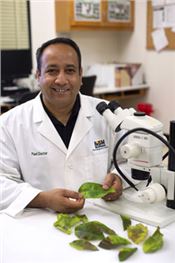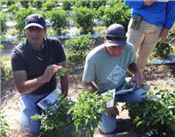AgCenter Plant Diagnostic Center Marks 10 Years Of Solving Plant Health Problems
OLIVIA MCCLURE
BATON ROUGE, LOUISIANA
In the past 10 years, Raj Singh and his staff at the LSU AgCenter Plant Diagnostic Center have examined thousands of plant samples mailed to them by home gardeners and commercial growers in search of answers to their horticultural problems.
From fungal infections to insect pests to nutrient deficiencies, the Plant Diagnostic Center has seen it all.
“Plants get sick like we get sick, and they cannot tell us their problems,” said Singh, director of the center. “So as a plant doctor, I find the cause and treatment of their problems.”
The Plant Diagnostic Center launched in 2010 to provide both the commercial horticulture industry and the general public a one-stop shop for identifying plant health problems and solutions. Its staff recently combed through data collected from 2010 to 2020 to see what kind of impact the center has had in its first 10 years.
In that time, the center has processed more than 6,000 physical plant samples and more than 2,500 digital samples, which usually come in the form of photos, from across Louisiana. Singh also has made about 500 visits to home gardens and commercial horticulture operations to diagnose more complicated cases.
The majority of physical samples – 71 percent – are sent in by commercial growers. Photos of plant health issues tend to come from homeowners or parish AgCenter agents sending them on constituents’ behalf. Singh replies not just with the diagnosis, but also best management practices that can be implemented to resolve the problem and prevent it from recurring.
Fungal and fungal-like microorganisms account for 41 percent of diagnoses in the past 10 years, followed by bacterial infections (13 percent). Smaller percentages are attributed to viral plant pathogens, insect pests and mites. Another 14 percent of plant problems seen in the past decade stem from abiotic factors, including soil pH, soil compaction and poor drainage, nutrient deficiencies and chemical phytotoxicity.
Uncovering exactly which of these problems is making a plant “sick” takes a little detective work. Sometimes, visual inspection of a sample or photo is enough to make the call. But many conditions share similar symptoms. At the Plant Diagnostic Center, a variety of tools are used to make diagnoses, including examining samples under a microscope, cultural isolation and molecular diagnostic techniques.
Seeing so many “patients” has given the Plant Diagnostic Center a front-row seat to emerging plant health problems – placing it on the frontlines when it comes to responding to high-impact diseases like citrus canker or boxwood blight.
“The center serves as a sentinel for the discovery of new pathogens that our growers may be facing,” said Stuart Gauthier, AgCenter agent in St. Martin Parish.
Since 2010, Singh has published 18 new disease reports in peer- reviewed scientific journals – new findings on hosts and pathogens or their spread to new geographic locations.
“This information is important to advisers, growers, diagnosticians, researchers, regulatory officials, other practitioners and the public,” Singh said.
The Louisiana Department of Agriculture and Forestry depends on the center for diagnostic support to help determine whether plant pathogens warrant quarantines or other urgent measures.
“Through the years the PDC has been the basis for making sound quarantine decisions for citrus diseases, palm tree disease and Phytophthora ramorum,” said Ansel Rankins, LDAF assistant commissioner. He added that Singh has helped the department train its inspectors on how to take samples in the field, identify pests and relay information to the public.
“Our business could not thrive without the help and support of Dr. Singh and the PDC,” Rankins said.
The center also is a resource for AgCenter extension agents and specialists, helping them to be able to resolve queries from their constituents.
“When I make a preliminary diagnosis but tell the client I want to confirm it with the Plant Diagnostic Center, it gives them confidence in the final prognosis and keeps me from making a misdiagnosis,” said Joe Willis, AgCenter agent in Orleans Parish. “And when I am completely stumped by what I see, the PDC is there to bring clarity and provide answers.”
“Confidence in knowing the exact pathogen that is causing disease is paramount in developing a plan to move forward with clients,” said Will Afton, AgCenter agent in St. Tammany Parish. “The quicker I can confirm a plant pathogen, the quicker I can start a management plan with the client.”
Dan Devenport, AgCenter agent in Lafayette Parish, noted the center’s benefits to licensed landscape horticulturists.
“Recommended control options provided by the PDC assists licensed landscapers with commercial applicator’s licenses and gives them the best options they need to service their clientele,” he said.
Other accomplishments at the Plant Diagnostic Center in the past 10 years include:
• Publishing more than 50 fact sheets distributed to consumer and commercial clientele.
• Conducting 285 extension seminars delivered to 1,460 ornamental and turfgrass professionals; 1,670 Master Gardeners; and 9,264 commercial and consumer stakeholders.
• Training 282 AgCenter agents on plant pathology and plant diagnostic matters to give them more confidence to address plant health questions brought to them by clientele.
• Participating in 108 free plant health clinics where the general public can get their plant questions answered.
• Hosting 22 international scholars. ∆

LSU AgCenter plant doctor Raj Singh directs the Plant Diagnostic Center, which launched in 2010 as a one-stop shop for
identifying plant health problems and solutions. Here, he is photographed in his lab examining plant samples.

LSU AgCenter plant doctor Raj Singh, who directs the Plant Diagnostic Center, during a site visit to train
McIlhenny Company employees in diagnosing and treating pest problems in their pepper fields.
LSU AgCenter file photos